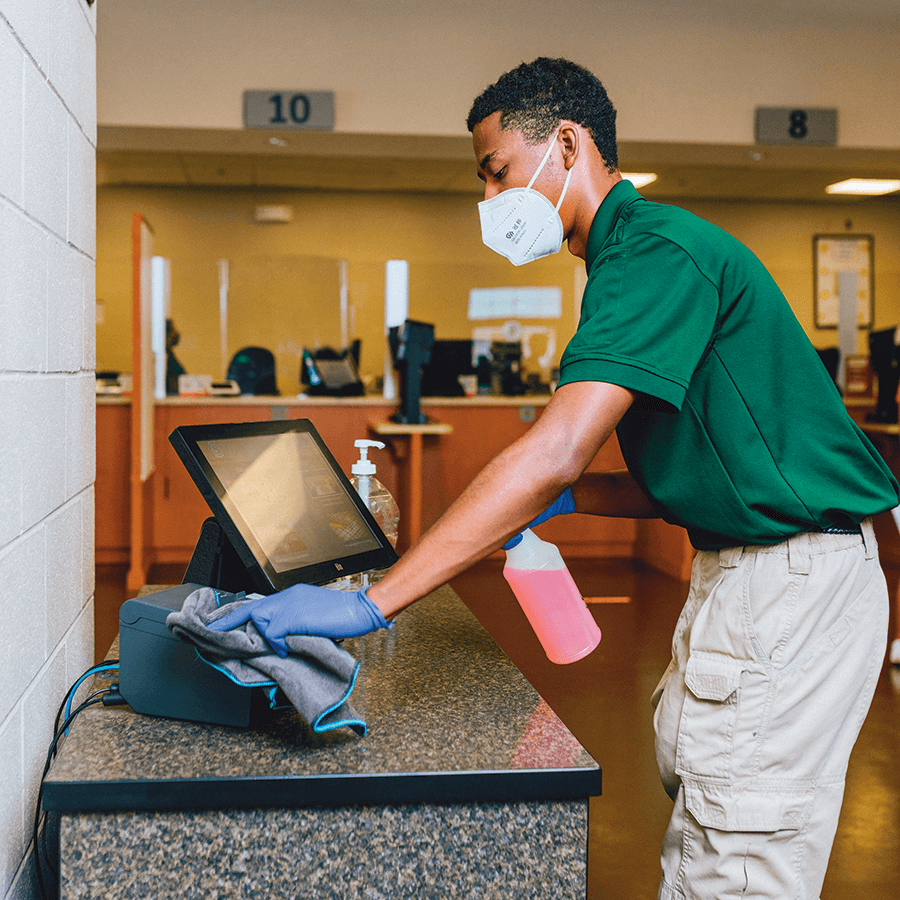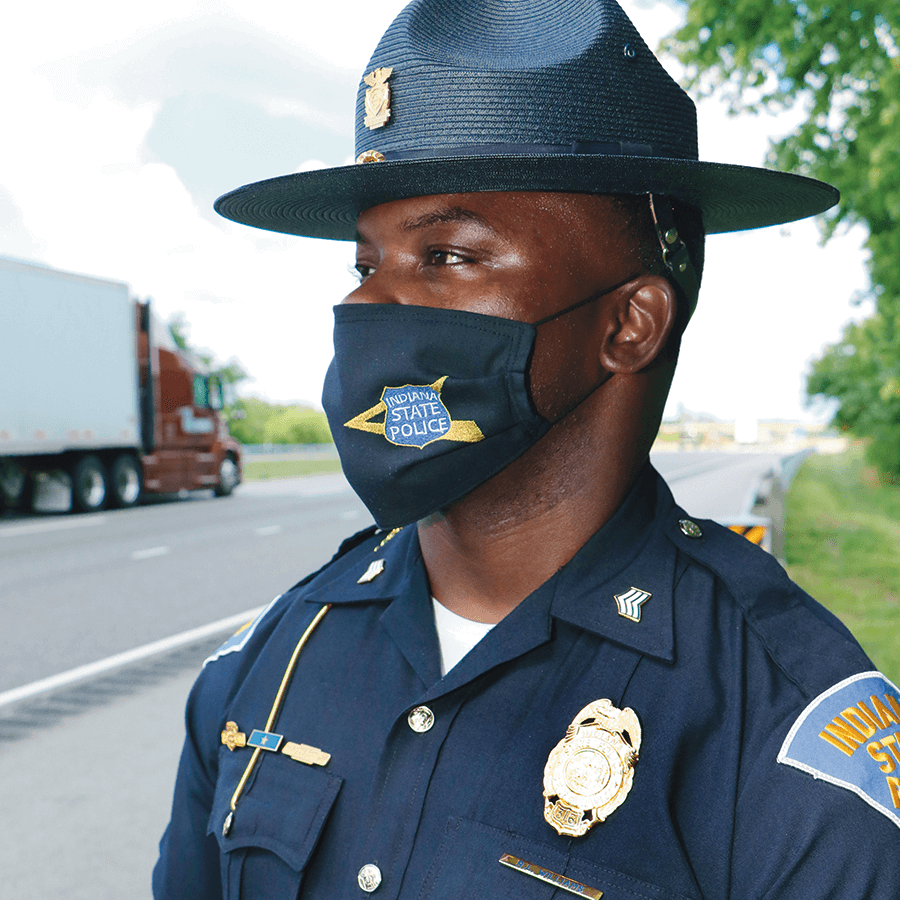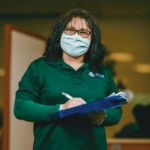Unprecedented Adaptations
Motor vehicle administrations and law enforcement respond to the COVID-19 pandemic
In the midst of the COVID-19 pandemic, the work of many official entities has continued. Law enforcement, fire and rescue and other first responders have stayed on the job, albeit with new physical-distancing guidelines and personal protective equipment (PPE). Government offices, including many motor vehicle administrations, have drastically reduced hours or closed face-to-face operations depending on the severity of their region’s infection rate. And, as has been the case during previous emergencies, administrators, officers and staff have found new ways to continue to serve the public.
In Québec, Canada, Renée Delisle is a director of SAAQ (Société de l’assurance automobile du Québec), the provincial vehicle administration. At outlets that have stayed operational (strictly for essential commercial driver services), care has been taken to maintain safe contact among staff and customers. SAAQ has closed every other counter, plexiglass has been placed between stations and counters are sanitized after each encounter on both the customer side and the employee side. “We encouraged the use of debit cards, since cash is problematic,” Delisle says.
Some of SAAQ’s services are available online, but it was not able to scale up as quickly as it would have liked. “We are in the middle of modernization,” reports Delisle. “It was hard to put new services online, so we did more transactions by phone.” SAAQ has also modified existing requirements, such as using old photos for renewed licenses or mailing in the paperwork to register the sale of a vehicle.
Amber Bell has been a driver examiner with the Georgia DDS for six years. “I am proud to be an essential employee. DDS has implemented contactless road skills tests which allow us to continue issuing licenses to new drivers.”
By early March, California’s Department of Motor Vehicles responded to the shifting landscape of the disease in the community and information coming from state and federal health officials. The department was able to take advantage of work begun in the summer of 2019 to streamline many of its processes, moving certain services online that had previously required an in-person visit. It initiated deep cleaning and social distancing in the field offices and encouraged customers to stay outside of the building and wait for a text notification before coming to a service window.
Steven Gordon, director of California Department of Motor Vehicles (DMV), explains that the department was able to utilize a variety of existing service channels as safety requirements changed. “Think about them like items in your pantry, and you’re wondering what to make,” he says. “We have a ticketing system, an online portal and a bunch of other solutions that we can bring to bear; we just needed to assemble them in a different way to set up the virtual field office.”
Within a couple of weeks, Gordon reports, California DMV’s virtual field offices were up and running, first with a soft launch and then with a full rollout. This was in addition to transactions that could be completed by mail or at standalone kiosks throughout the state. Gordon also mentions that tried-and-true channels, such as the U.S. Postal Service, were still perfectly viable. “We’ve been using the USPS for close to 100 years. It’s one of our biggest channels, and many people actually prefer it. If they want more immediate service, they can use the call center,” he says. “In addition, these days, everyone has a smartphone, so you can send us an image of your documents, and our machine-learning tools will kick off our processes automatically. That’s our design goal—our services should be available where our customers are.” Gordon says the DMV is setting up more services to be mobile-first in order to reach the state’s far-flung communities.

In the days just prior to the stay-at-home order in Michigan, the secretary of state also reevaluated its operating model. Winnie Liao, chief operating officer, Michigan Department of State, says initiatives were already in place that allowed for a nimble response as situations warranted. The department cut back walk-in services in branches, then offered in-person service by appointment only. “Faced with the uncertainties and the closure of all 131 branch offices, the administration was focused on balancing the safety of our staff and the public while continuing to serve critical needs across the state,” Liao says. “We partnered with agencies and associations across the state to ensure that we prioritized transactions that supported first responders and critical infrastructure workers, and those were processed in six designated emergency branch offices across the state.” Senior administrators also met with the Michigan State Police, Department of Transportation and governor’s office to coordinate handling commercial driver license (CDL) and class A license extensions, waiving late fees and expirations until the summer. “Nobody should have to make the choice between spending $20 on a [license] renewal versus food,” says Liao.
Of course, many jurisdictions had to extend expiration dates for driver licenses or come up with new procedures to enable renewals. Washington, one of the first states to report COVID-19 cases, closed its licensing offices in late March. Its Department of Licensing issued new rules, allowing residents under the age of 24 or over 70 to renew their licenses online for a limited time and suspended the requirement to visit a licensing office every other 6-year renewal period. “With those eligibility barriers removed, about 90,000 additional customers who were previously required to go to an office have been able to renew or replace their license online,” reports Christine Anthony, a communications manager with the Washington State Department of Licensing.
“As the pandemic intensified and the impacts increased, we found that our emergency plans did not adequately address pandemic-specific needs,” Anthony continues. “Our Incident Management Team (IMT) created several procedures along the way to solve these problems and guide employees along the correct path. The new documents and the relevant information from the emergency plan will be combined into a pandemic plan at the end of the emergency.”
Enjoying the telecommute
Across North America, most workers who could began to work from home. SAAQ closed its main office, and its employees were deployed in different roles that could be accomplished from home or elsewhere. “Most are doing the same work as they would regularly,” says Delisle, “but if you can’t do it from home, you’re doing other tasks.”
They and other government employees were given a short training session, so they could work in the province’s call center. These employees took calls from the public on general issues surrounding COVID-19. From 8 a.m.–8 p.m. every day, operators were able to answer questions such as, “Can I travel?” or “My girlfriend is returning from traveling abroad, should I stay with her or move into my parents’ home?” with guidance from health officials.
SAAQ was one of the first agencies to convert their call center, and employees were able to fill in gaps as their work-from-home schedules allowed. The redeployment was a real boon to employees who were taking care of kids who were home from school or daycare centers, or children with special needs. They were not obligated to work but could work a limited schedule, if necessary.
Maria Pabon is a driver examiner in Locust Grove, Georgia. “I know many customers are having a hard time. I try to be upbeat and make sure they leave smiling.”
The Texas DMV (TxDMV) was able to send computer equipment to employees to use at home, according to Shelly Mellott, deputy executive director, TxDMV. There was a blanket stay-at-home order from the governor, but state agencies were still required to provide services to the public, additional stay-at-home orders with more restrictions were made county by county. Citizens who had business with TxDMV, which is responsible for vehicle registrations but not driver licensing, were able to go to another county if their local office was closed. Skeleton crews remained at each TxDMV office to handle mail and other transactions. Mellott estimates that 85% of the staff began telecommuting and were successfully dealing with increased call volume by utilizing staff that would normally be working in an office providing in-person service.
Normally, she says, “We do in-person training with dealers and other stakeholder groups, and even new employees coming in. We’ve canceled the in-person training and moved to virtual training and onboarding.”
Tech to the rescue
The law enforcement community also has had a strong reliance on tech solutions. In Delaware, Lt. Col. Melissa Zebley, second in command of the state police, shares there was a variety of efforts that helped. “It is hard to forge partnerships in a crisis, but we were well positioned because we had those in advance. Even in this new uncertain event, the process worked,” she says. The department expanded its use of Zoom, WebEx and Skype, for example, allowing teams to have critical conversations, just in a new way. Zebley says the state police used internet tools to keep troopers apprised of policy changes and health care information. She credits seamless communication with the jurisdiction’s DMV, for example, which alerted them to changes so that troopers weren’t issuing unnecessary citations when expirations were being relaxed, or with the Department of Corrections who clarified personal safety expectations around prisoner drop-offs.
With so many directives and policy changes coming out almost daily, there was a danger of information overload. Zebley credits their “small, excellent” web team with creating and updating pages on their intranet site on preparedness topics, such as decontaminating a vehicle, in a cataloged format accessible at any time.
The International Association of Chiefs of Police (IACP) is using its website for similar information sharing. Steven Casstevens, chief of police for Buffalo Grove, Illinois, and current IACP president, says that the association has “hosted different webinars for our membership on domestic violence, policing policies, fire and EMS, and leadership. Our in-person meetings have been canceled, but we have been able to share so much information; we’ve had 45,000 views on the COVID-19 information page.”
Law enforcement adjustments

Operating in a smaller state with just under 1 million residents, Delaware State Police has 700 sworn officers and 250 non-sworn; the latter were moved into telecommuting roles. For officers working in the community, Zebley made the point that Delaware worked closely with its neighboring states Pennsylvania, New Jersey and Maryland to be sure that rules in one jurisdiction did not conflict with those in an adjacent jurisdiction. “A lot of our retail customers come from other states, so we wanted to make sure visitors and others [were following the same restrictions]. We tried to get citizen compliance before moving to enforcement,” Zebley says.
“We have a small state with great infrastructure,” Zebley continues. The Delaware Emergency Management Agency (DEMA) outlines how to share resources during emergencies, which are usually in the form of hurricanes or flooding, but elements were put to good use in the current pandemic. “The infrastructure was there to address the needs you might have—how to generate supplies when needed and distribute them accordingly, and how to maintain a surplus in the event they are needed downstream.”
California has seen more than its share of natural disasters, but even its pandemic response playbook was challenged. “This is a large state that deals with fires and earthquakes; we have had to update our continuity of operations/government plan as well as the departmental pandemic operations plan,” reports Sven Miller, commander, Office of Community Outreach & Media Relations, California Highway Patrol (CHP). “We had to alter [the protocol] to allow masks on a patient or arrestee if they exhibit symptoms, much as we would do with a tuberculosis patient.
“We have provided assistance in many emergencies, from solo vehicle collisions to catastrophic incidents like the Loma Prieta or Northridge earthquakes,” continues Miller. “We learn something from each one we respond to. The CHP constantly strives to improve our ability to effectively respond to those incidents, and this will be no different.”
When it comes to the safety of CHP officers, Miller says they are already trained to be aware of pathogens in public encounters. But the department recognizes how important it is to care for its employees. “There has been a lot of false information [about the coronavirus] circulating, so we are giving [employees] real information to protect themselves and their family members. We are continuing to implement the policy of 6-foot distancing in offices and briefing rooms. Area offices are being regularly cleaned and sanitized. And when there have been a few cases among our staff, we took immediate action to sanitize the work area.”
Sharing clear, reliable information has also been a focus for the Kansas Highway Patrol, explains Capt. Andrew N. Dean of the Kansas Highway Patrol Public & Governmental Affairs. “We were fortunate, as an agency, to have sufficient PPE for our initial response. However, acquiring additional PPE for the future has proven difficult and has required creativity and innovation,” he says. “The pandemic has created the need for the agency to communicate with its staff on a much more frequent basis, which has helped to ensure that any pertinent information relating to COVID-19 is properly shared and distributed with all agency employees.”
Beyond the new normal adjustments to policing and facilities, several jurisdictions had to cancel or postpone important community events and/or training for recruits. Casstevens says that his officers were disappointed to cancel their annual fundraiser for Special Olympics through the Cop on a Rooftop event, where they would raise thousands of dollars in one day. “We canceled Fourth of July events, Buffalo Grove Days and our Pride parade,” he shares. “Even the smaller things like police station tours for [youth] Scouts and college internships are a loss. And our police officers in training were sent home from academies. Illinois has a number of different academies; some are slowly reopening, but others, like College of DuPage, have remained closed.”
Miller at CHP had a similar list of suspended activities, including typical outreach programs—distracted-driver awareness month, educational presentations, bike rodeos and driver safety classes had to be canceled. “The commissioner suspended academy training,” he reports. “Senior cadets had only six weeks of training left, but at least they were sent to area offices to continue onsite training.”
The silver lining
Several offices have agreed that this emergency is actually having some positive effects. “This has forced us to change our way of doing business,” Casstevens says, “and we will carry some new processes into future, like residents being able to complete a police report through our portal or over the phone.”
Liao believes many more employees at the Michigan Department of State will continue to telecommute on a full-time basis. “There’s no rush to bring people back now that they are successfully working remotely.”
Mellot in Texas concurs. “Only 5% to 10% of full-time employees, and 5% of part-time were telecommuting before. It was quite a lift to get everyone working from home, but we are finding people are actually more productive. They are taking more calls and issuing more dealer licenses—30,000 in state—and the turnarounds are faster.
“Budget-wise, it might save money; there are cost savings for us and the employees who aren’t paying for gas or tolls,” she continues. “For some, this cuts out a one-and-a-half-hour commute. We won’t have to expand facility space. I don’t know if we’ll ever go completely back, especially since performance rates are up.”





